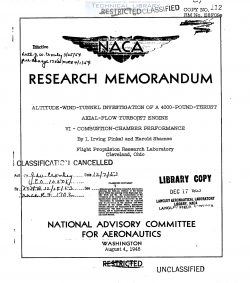naca-rm-e8f09e
- Version
- 66 Downloads
- 1.91 MB File Size
- 1 File Count
- April 21, 2017 Create Date
- April 21, 2017 Last Updated
National Advisory Committee for Aeronautics, Research Memorandum - Altitude Wind Tunnel Investigation of a 4000 Pound Thrust Axial Flow Turbojet Engine - VI - Combustion Chamber Performance

An analysis of the performance of the types A, B, and C com-
bustion chambers of the 4000-pound-thrust axial-flow turbojet
engine is presented. The data were obtained from investigations
of the complete engine over a range of pressure altitudes from
5000 to 40,000 feet and ram pressure ratios frcm 1.00 to 1.86.
The combustion-chamber pressure losses, the effect of the losses
on cycle efficiency, and the combustion efficiency are discussed.
The type A combustion chamber had the highest over—all (total)
pressure loss and the type C the lowest, of the three combustion
chambers investigated when used under equivalent engine configura-
tions and operating conditions. Pressure losses due to friction
were highest for the type A and lowest for the type C combustion
chamber; pressure losses due to heat addition to the air flowing
in the combustion chamber were highest for type 0 and lowest for
type A. The variation with altitude of the ratios of the pressure
losses due to heat addition and those due to friction to the
combustion-chamber inlet total pressure, called the momentum and
friction pressure-loss ratios, respectively, was negligible for
the type A combustion chamber. The data for the type B combustion
chamber showed that the friction pressure-loss ratio increased,
and the momentum pressure-loss ratio decreased, with increasing-
ram pressure ratio.
The loss in cycle efficiency due to the pressure losses in
the combustion chamber was found to be of little consequence in
the design operating range of the engine. At low engine speeds,
however, this loss in cycle efficiency can be as large as 50 per-
cent of the cycle efficiency attained.
The data taken at static conditions and a. pressure altitude of
5000 feet show the type B combustion chamber to have the highest
and the type A the lowest combustion efficiency. The combustion
efficiency improved with engine speed and ram pressure ratio at all
altitudes and decreased with increasing altitude. At rated engine
speed the altitude effect on combustion efficiency was no greater
than 5 percent for the range of pressure altitudes investigated.
| File | Action |
|---|---|
| naca-rm-e8f09e Altitude Wind Tunnel Investigation of a 4000 Pound Thrust Axial Flow Turbojet Engine - VI - Combustion Chamber Performance.pdf | Download |

Comment On This Post